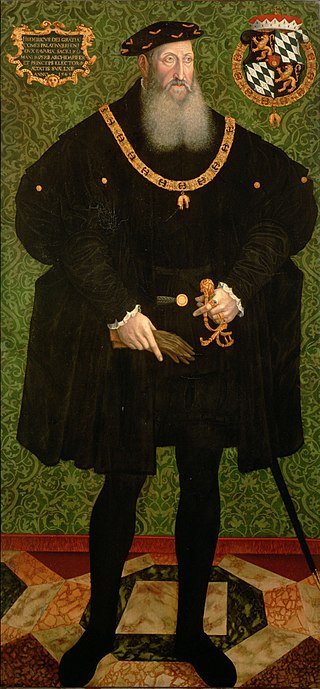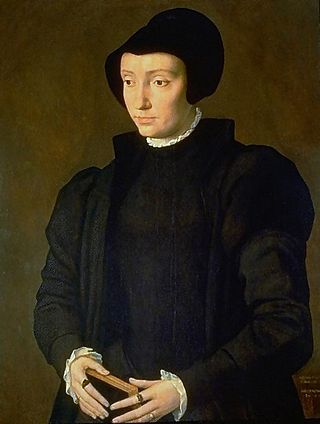Related Research Articles

Catherine of Aragon was Queen of England as the first wife of King Henry VIII from their marriage on 11 June 1509 until their annulment on 23 May 1533. Born in Spain, she was Princess of Wales while married to Henry's elder brother, Arthur, Prince of Wales, for a short period before his death.

Joachim I Nestor was a Prince-elector of the Margraviate of Brandenburg (1499–1535), the fifth member of the House of Hohenzollern. His nickname was taken from King Nestor of Greek mythology.

Christian III reigned as King of Denmark from 1534 and King of Norway from 1537 until his death in 1559. During his reign, Christian formed close ties between the church and the crown. He established Lutheranism as the state religion within his realms as part of the Protestant Reformation, and was the first King of Denmark-Norway.

René of Chalon, also known as Renatus of Chalon, was a Prince of Orange and stadtholder of Holland, Zeeland, Utrecht and Gelre.

Isabella of Austria, also known as Elizabeth, was Queen of Denmark, Norway and Sweden as the wife of King Christian II. She was the daughter of King Philip I and Queen Joanna of Castile and the sister of Emperor Charles V. She ruled Denmark as regent in 1520.

Antoine, known as the Good, was Duke of Lorraine from 1508 until his death in 1544. Raised at the French court, Antoine would campaign in Italy twice: once under Louis XII and the other with Francis I. During the German Peasants' War, he would defeat two armies while retaking Saverne and Sélestat. Antoine succeeded in freeing Lorraine from the Holy Roman Empire with the Treaty of Nuremberg of 1542. In 1544, while Antoine suffered from an illness, the Duchy of Lorraine was invaded by Emperor Charles V's army on their way to attack France. Fleeing the Imperial armies, Antoine was taken to Bar-le-Duc where he died.

Eleanor of Austria, also called Eleanor of Castile, was born an Archduchess of Austria and Infanta of Castile from the House of Habsburg, and subsequently became Queen consort of Portugal (1518–1521) and of France (1530–1547). She also held the Duchy of Touraine (1547–1558) in dower. She is called "Leonor" in Spanish and Portuguese and "Eléonore" or "Aliénor" in French.

Ippolito de' Medici was the only son of Giuliano di Lorenzo de' Medici, born out-of-wedlock to his mistress Pacifica Brandano.

Christina of Denmark was a Danish princess, the younger surviving daughter of King Christian II of Denmark and Norway and Isabella of Austria. By her two marriages, she became Duchess of Milan, then Duchess of Lorraine. She served as the regent of Lorraine from 1545 to 1552 during the minority of her son. She was also a claimant to the thrones of Denmark, Norway and Sweden in 1561–1590 and was sovereign Lady of Tortona in 1578–1584.

Infanta Beatrice of Portugal was a Portuguese princess by birth and Duchess of Savoy by marriage to Charles III, Duke of Savoy. She was the ruling countess of Asti from 1531 to 1538.

William of Jülich-Cleves-Berge was a Duke of Jülich-Cleves-Berg (1539–1592). William was born in and died in Düsseldorf. He was the only son of John III, Duke of Jülich-Cleves-Berg, and Maria, Duchess of Jülich-Berg. William took over rule of his father's estates upon his death in 1539. Despite his mother having lived until 1543, William also became the Duke of Berg and Jülich and the Count of Ravensberg.

Francisco de Quiñones, O.F.M., was a Spanish Franciscan friar and later cardinal who was responsible for some reforms in the Catholic Church in Spain.

Frederick II, Count Palatine of the Rhine, also Frederick the Wise, a member of the Wittelsbach dynasty, was Prince-elector of the Palatinate from 1544 to 1556.

François de Tournon was a French Augustinian friar, an archbishop, diplomat, courtier, and cardinal. From 1536 he was also a military supply officer of French forces operating in Provence, Savoy and Piedmont. In the same year he founded the Collège de Tournon. For a period he was effectively France's foreign minister. He was a prominent leader in the fight against Lutheranism and Calvinism, especially at the French Royal Court, and what he perceived as the growing Huguenot menace to both doctrinal orthodoxy and the social order. He took a prominent role in the Estates General of 1560, the Colloquy of Poissy and the Colloquy of Saint-Germain in 1562. He participated in the papal conclaves of 1534, 1549, and 1559.

The Habsburg Empire of Charles V and its allies conquered Tunis in 1535, wresting the city away from the control of the Ottoman Empire.

Dorothea of Denmark and Norway was a Danish, Norwegian and Swedish princess and an electress of the Palatinate as the wife of Elector Frederick II of the Palatinate. She was a claimant to the Danish, Norwegian and Swedish thrones and titular monarch in 1559–1561.
Sir Thomas LeighorLegh (?1511–1545) was an English jurist and diplomat, who played a key role as agent of Henry VIII and Thomas Cromwell in the Dissolution of the Monasteries.

Cornelis de Schepper, Cornelis Duplicius de Schepper or Cornelius de Schepper (1503?-1555) was a Flemish mathematician, counselor and ambassador for the Holy Roman Emperor Charles V, Ferdinand I of Austria and Mary of Hungary, governor of the Netherlands. He is also known by his Latin name Scepperus.

Ruard Tapper was a Dutch theologian of the Catholic Reformation, a chancellor of Leuven University, and an inquisitor.
References
- ↑ 1. Martin Schwartz Lausten in Bietenholz (1987) – vol.1 pg.443